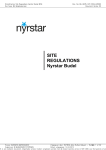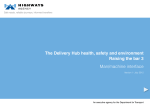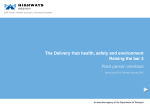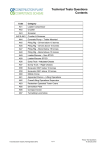Download HOISTING AND LIFTING
Transcript
HSE guidelines S November 2014 HOISTING AND LIFTING HSE LIFE THE NATIONAL OIL&GAS INDUSTRY STANDARD FOR PROFESSIONALS HOISTING AND LIFTING Work safely or do not work at all Operations on installations and systems are covered by strict procedures. After all, there is always a risk that components on an installation have not been secured. You should therefore carefully read the permit to work and check that the control measures that are described are actually in place. Then, take the precautionary measures needed for the work you are going to carry out. Speaking the same clear language regarding Health, Safety and Environment, and harmonisation of regulations by focusing primarily on agreements between companies and contractors. That is the goal the member parties of HSElife UNIO pursue. As well as the information that has already been harmonised, location and company-specific information also applies. Ask for it! HOISTING AND LIFTING HOISTING AND LIFTING With all hoisting and lifting operations, there is an increased risk of personal injury or damage. There is more to hoisting and lifting safely than just knowing the correct techniques and using the right materials and equipment. It also involves training and experience. Only then can you make an accurate assessment in advance of the risks of the work and carry it out safely. • hoisting and lifting: vertically transporting a load • hoisting: the load is freely suspended • lifting: the load is raised through a fixed ‘route’ HOISTING AND LIFTING HOISTING AND LIFTING EQUIPMENT Hoisting equipment mobile cranes, offshore cranes, overhead cranes, gantry cranes, column cranes, truck mounted cranes, telescopic handlers with hoisting function, earth-moving machines with hoisting function, chain hoists, … Hoisting tools Hoisting fasteners, chains, slings, webbing slings, ... Lifting equipment Forklift trucks, telescopic handlers, jacks, aerial platforms, loading and unloading flaps behind trucks, ... Lifting tools Lifting scoops, pallet hooks, ... HOISTING AND LIFTING DANGERS OF HOISTING AND LIFTING WORK Every situation is different, so take care: • a different location or a location where there have been changes • different weather conditions or changed weather conditions • different cranes (from a crane-hiring company) • a different hoisting and lifting team HOISTING AND LIFTING RESPONSIBILITIES Location manager /supervisor - has overall responsibility for all the activities on a site. Person in Charge - has overall responsibility for hoisting and lifting operations Everyone - responsible for carrying out work safely HOISTING AND LIFTING TOOLBOX MEETING • compulsory before the start of any work operations • discuss the whole scenario in full • discuss everyone’s task and role • discuss all the hazards and risks HOISTING AND LIFTING ROUTINEMATIGE WERKZAAMHEDEN* • moving loads to and from supply vessels • moving loads on the platform • moving the water supply hose to and from the supply vessel * Follow the operating instructions HOISTING AND LIFTING NON-ROUTINE OPERATIONS* • hoisting in or above hazardous zones or in extraordinary locations (e.g. over pressurised pipes) • hoisting with non-standard hoisting equipment • hoisting in adverse weather conditions • transporting people, using a ‘personnel basket’ or work bin • moving the fuel supply hose to and from the supply vessel • loading methanol with transport tanks • hoisting materials where space is limited • hoisting loads with unusual dimensions. * Follow the operating instructions * Permit to Work, TRA, LMRA, hoisting plan and work programme are compulsory If you have any doubts about the nature of the hoisting operations (whether they are routine or non-routine), check with your supervisor! HOISTING AND LIFTING HOISTING TOOLS Preventing mistakes? • work with material that is one hundred percent reliable ( = approved) • check the tools yourself every time before you start to use them (visual check for approval, defects, and damage) HOISTING AND LIFTING CERTIFICATE Copies of the certificates are available at the site as is all the information about the origin, condition and approvals for all the hoisting equipment. HOISTING AND LIFTING COLOUR CODING This states the year in which the hoisting equipment was checked and approved: YELLOW - 2012 RED - 2013 BLACK - 2014 GREEN - 2015 BROWN - 2016 BLUE - 2017 YELLOW - 2018 Etc. HOISTING AND LIFTING RATING PLATE For chains, chain assemblies, steel cable slings, hoisting clamps, and hoisting equipment: • manufacturer details • identification number • the Safe Working Load Limit • the CE mark • the nett weight of more than 100 kg HOISTING AND LIFTING INSPECTION STATUS An inspection sticker is often affixed to the rating plate: • date of inspection • date of next inspection Sticker not present (or no longer present): • colour coding plus certificate are valid as proof of inspection Hoisting tools without an inspection sticker - but with the right colour coding and with a rating plate - may be used, unless they are damaged or defective. Hoisting tools without colour coding or rating plate: • find the certificate if possible • mark the equipment clearly • store it in a separate location • do not in any circumstances use the equipment HOISTING AND LIFTING INSPECTION STATUS Hoisting equipment with damage or defects: • make sure straight away that the equipment is no longer used • deposit it in the waste container or mark it “to be repaired” If you are in doubt about the condition or inspection status of hoisting equipment: • do not allow work to commence, or stop work if it has already begun! HOISTING AND LIFTING LOCATION OF INFORMATION ON SAFE WORKING LOAD (SWL) • hoisting equipment: on the rating plate • synthetic hoisting straps: on the label Note: the SWL must never be exceeded. HOISTING AND LIFTING WORK LOAD FACTOR Using the hoisting equipment at a particular angle: apply the work load factor WORK LOAD FACTOR x SAFE WORKING LOAD = WORK LOAD (≤ hoisting equipment SWL) HOISTING AND LIFTING WORK LOAD FACTOR Please note that incorrect use multiplies the forces on the hoisting equipment and material. HOISTING AND LIFTING WORK LOAD FACTOR HOISTING AND LIFTING WORK LOAD FACTOR Please note that there are special workload tables for chain assemblies, steel cable assemblies, synthetic hoisting straps, twin straps and sling combinations. HOISTING AND LIFTING SYNTHETIC HOISTING STRAPS Synthetic hoisting straps should be inspected periodically (at least once a year), as should all hoisting and lifting equipment. Visual inspection (each time before it is used): • presence of the identification label • legibility of the label • completeness of all the information • friction pads • holes caused by welding • damage to load-bearing stitching • any damage to the outer layer in the case of round hoisting straps • chemical damage • heat damage Colour coding on synthetic hoisting straps indicate the Safe Working Load. HOISTING AND LIFTING KUNSTSTOF HIJSBANDEN Please note: not every manufacturer uses the same colour codes. You should therefore always read the SWL on the label. Damaged hoisting strap: • ‘take a knife to it’ • deposit the remnants in the appropriate container HOISTING AND LIFTING BEFORE YOU START WORK • routine or non-routine? • Permit to Work/ hoisting plan/ work programme • are steering lines needed? • meet and discuss in advance with everyone involved (crane operator, banksman and fitters and riggers) • test the communication devices (walkie-talkie) • choose the proper materials and hoisting tools • check inspections and certificates • check the condition of the materials and tools every time before you start using them • check the place of work and escape routes (that they are free of obstacles) • carry out an LMRA (Last Minute Risk Analysis) Be actively involved in toolbox meetings. HOISTING AND LIFTING BEFORE YOU START WORK • is everyone involved familiar with the rules and procedures for the hoisting operation? • has everyone involved been to the toolbox meeting? • does everyone know who is the person responsible during this hoisting operation? • is everyone qualified and aware of their task? • does everyone know in what weather conditions the hoisting operations must be stopped? • has the TRA been made for non-routine operations and does everyone understand the hoisting operation and the precautionary measures to be taken? HOISTING AND LIFTING DURING THE WORK • apply the correct techniques • use the correct materials and hoisting tools • use materials and hoisting equipment in the correct manner • ensure the best-possible visibility at the place of work • ensure maximum contact (visually, and/or via a walkie-talkie) Remain alert while work is being carried out. HOISTING AND LIFTING FORKLIFT TRUCKS Please note: • high centre of gravity • narrow wheel base Result: forklift trucks can easily overturn! HOISTING AND LIFTING ACCIDENTS MOST IMPORTANT CAUSES 1. lack of training and experience (driver) 2. unsuitability of forklift truck for the work 3. ‘flashy’ steering by the driver 4. unsuitable work surface 5. poor maintenance and inspections HOISTING AND LIFTING PREVENTING ACCIDENTS The driver must • have specific forklift truck training • have been given an explanation about the work operations, the surface, and the dangers • read and understand the user instructions, and act in accordance with them • feel physically and mentally fit • wear the safety belt • work in a responsible manner HOISTING AND LIFTING PREVENTING ACCIDENTS The forklift truck itself must • be suitable for the work • be fitted with user instructions (by the manufacturer) • be fitted with a safety belt • be maintained in accordance with the instructions • be approved HOISTING AND LIFTING PREVENTING ACCIDENTS The site/surroundings must • be free of uneven or slippery surfaces, obstacles (pipe bridges, railway tracks, flush gutters, …) • where work involving forklift trucks is carried out, be separated from places where pedestrians or cyclists pass by HOISTING AND LIFTING EVALUATION • debriefing after the work • core question: could the work have been done differently or more safely? • the aim: to learn from and with each other HOISTING AND LIFTING QUESTIONS? MORE INFORMATION? You can always approach the site manager/supervisor The member parties of HSElife UNIO are: SHELL/NAM TAQA Energy Centrica Energy Upstream Oranje-Nassau Energie CASOS Petrogas GDF SUEZ Vermilion Energy Dana Petroleum TOTAL HSE LIFE LMRA Last Minute Risk Analysis ASK YOURSELF THE FOLLOWING QUESTIONS: Do I know what I need to do? Is the workplace safe? Are all safety procedures explained to me? Am I familiar with the hazards of my work (assignment)? Do I have proper safety equipment (PPE)? Do I have the right tools? Are my tools certified? Have I done everything possible to minimise the risk? If anything goes wrong, do I know what I’m supposed to do? All YES: start (of continue) the activity. If NO or in doubt: go to your supervisor and discuss the situation. HSE LIFE HOISTING AND LIFTING QUESTION 1. Why are the dangers of hoisting and lifting operations different each time? A) A location can be different or change. The weather conditions can be different or change and forklift trucks can easily tilt. You may have to deal with different cranes from another crane hiring company. Or the hoist and lift team changes. B) A location can be different or change. This also applies to weather conditions. You may have to deal with different cranes from another crane hiring company. Or the hoist and lift team changes. C) A location can be different or change. This also applies to weather conditions. You may have to deal with different cranes from another crane hiring company. Therefore the user manual changes. Or the hoist and lift team changes. HOISTING AND LIFTING ANSWER 1. Why are the dangers of hoisting and lifting operations different each time? A) A location can be different or change. The weather conditions can be different or change and forklift trucks can easily tilt. You may have to deal with different cranes from another crane hiring company. Or the hoist and lift team changes. B) A location can be different or change. This also applies to weather conditions. You may have to deal with different cranes from another crane hiring company. Or the hoist and lift team changes. C) A location can be different or change. This also applies to weather conditions. You may have to deal with different cranes from another crane hiring company. Therefore the user manual changes. Or the hoist and lift team changes. HOISTING AND LIFTING QUESTION 2. Who is responsible for hoisting and lifting operations? A) Everyone because everyone is responsible to perform work safely. B) The crane operator and the site manager or supervisor. C) The Person in Charge. HOISTING AND LIFTING ANSWER 2. Who is responsible for hoisting and lifting operations? A) Everyone because everyone is responsible to perform work safely. B) The crane operator and the site manager or supervisor. C) The Person in Charge. HOISTING AND LIFTING QUESTION 3. Which operations are routinely? A) Moving loads on the platform, hoisting materials where space is limited and loading methanol with transport tanks. B) Moving loads on the platform, moving loads to and from supply vessels and moving the water supply hose to and from the supply vessel. C) Moving loads on the platform, moving loads to and from supply vessels and moving the fuel supply hose to and from the supply vessel. HOISTING AND LIFTING ANSWER 3. Which operations are routinely? A) Moving loads on the platform, hoisting materials where space is limited and loading methanol with transport tanks. B) Moving loads on the platform, moving loads to and from supply vessels and moving the water supply hose to and from the supply vessel. C) Moving loads on the platform, moving loads to and from supply vessels and moving the fuel supply hose to and from the supply vessel. HOISTING AND LIFTING QUESTION 4. What should the driver of a forklift truck do to prevent accidents? A) He should have specific training in handling forklift trucks and wear safety belts. He should check if an inspection sticker is affixed to the rating plate and he should mark the hoisting equipment. He checks if there is no damage to the outside of the forklift truck. Finally, he must perform work in a responsible way. B) He should attent the toolbox meeting. He should have specific training in handling forklift trucks and wear safety belts. He should ensure that someone gives him instructions about activities, the site and the dangers. He should read the user manual and check if an inspection sticker is affixed to the rating plate. Finally, he must perform work in a responsible way. C) He should have specific training in handling forklift trucks and wear safety belts. He should ensure that someone gives him instructions about activities, the site and the dangers. He should read the user manual, understand it and act accordingly. He must be feeling fit physically and mentally. Finally, he must perform work in a responsible way. HOISTING AND LIFTING ANSWER 4. What should the driver of a forklift truck do to prevent accidents? A) He should have specific training in handling forklift trucks and wear safety belts. He should check if an inspection sticker is affixed to the rating plate and he should mark the hoisting equipment. He checks if there is no damage to the outside of the forklift truck. Finally, he must perform work in a responsible way. B) He should attent the toolbox meeting. He should have specific training in handling forklift trucks and wear safety belts. He should ensure that someone gives him instructions about activities, the site and the dangers. He should read the user manual and check if an inspection sticker is affixed to the rating plate. Finally, he must perform work in a responsible way. C) He should have specific training in handling forklift trucks and wear safety belts. He should ensure that someone gives him instructions about activities, the site and the dangers. He should read the user manual, understand it and act accordingly. He must be feeling fit physically and mentally. Finally, he must perform work in a responsible way. HOISTING AND LIFTING QUESTION 5. Where do you have to pay attention to before you start working? A) Note the following issues: • check if the work is routine or non-routine • is there a Permit to Work / hoisting plan / work Programme? • are steering lines needed? • meet in advance with all involved (crane operator, banksman and fitters and riggers) • test the communication devices (walkie-talkie) • choose the proper materials and hoisting tools • the correct inspections and certificates • check the condition of materials and tools before each and every use • check the site and evacuation routes (free of obstructions) • carry out an LMRA (Last Minute Risk Analysis) HOISTING AND LIFTING QUESTION 5. Where do you have to pay attention to before you start working? B) Note the following issues: • check if the work is routine or non-routine • check if you should apply the workload factor • is there a Permit to Work / hoisting plan / work Programme? • are steering lines needed? • meet in advance with all involved (crane operator, banksman and fitters and riggers) • test the communication devices (walkie-talkie) • choose the proper materials and hoisting tools • the correct inspections and certificates • check the site and evacuation routes (free of obstructions) • carry out an LMRA (Last Minute Risk Analysis) HOISTING AND LIFTING QUESTION 5. Where do you have to pay attention to before you start working? C) Note the following issues: • check if the work is routine or non-routine • check if you should apply the workload factor • is there a Permit to Work / hoisting plan / work Programme? • are steering lines needed? • meet in advance with all involved (crane operator, banksman and fitters and riggers) • test the communication devices (walkie-talkie) • choose the proper materials and hoisting tools • the correct inspections and certificates • ensure maximum visibility on the site • carry out an LMRA (Last Minute Risk Analysis) HOISTING AND LIFTING ANSWER 5. Where do you have to pay attention to before you start working? A) Note the following issues: • check if the work is routine or non-routine • is there a Permit to Work / hoisting plan / work Programme? • are steering lines needed? • meet in advance with all involved (crane operator, banksman and fitters and riggers) • test the communication devices (walkie-talkie) • choose the proper materials and hoisting tools • the correct inspections and certificates • check the condition of materials and tools before each and every use • check the site and evacuation routes (free of obstructions) • carry out an LMRA (Last Minute Risk Analysis)























































